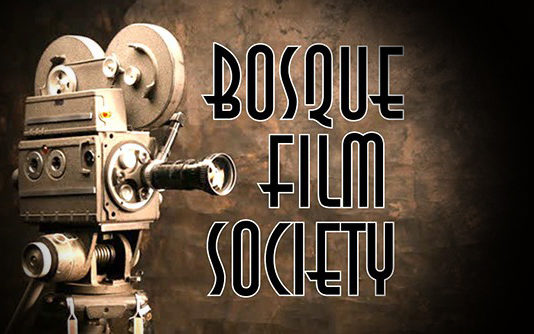See the legendary John Wayne in his breakthrough role in John Ford’s 1939 western classic “STAGECOACH” on the silver screen at the historic Cliftex Theatre in Clifton
By E. BRETT VOSS
Bosque Film Society Founding Board President
“If there’s anything I don’t like, it’s driving a stagecoach through Apache country.”
For the November screening of its monthly members-only FILM APPRECIATION NIGHT, the Bosque Film Society featured the 1939 breakthrough role for the legendary John Wayne in John Ford’s western classic “STAGECOACH” at 6:30 p.m. Tuesday, Nov. 28 at The Cliftex Theatre in Clifton. Delivering the classic western that truly started it all, Stagecoach remains Hollywood’s greatest ground-breaking western of all-time – first of all for providing the breakthrough role for the legendary John Wayne, and most importantly, for establishing the blueprint for the talkie western genre.
 For those who have never seen it before, viewers might end up experiencing a phenomenon known as a bit of déjà vu, first of all feeling like a scene from the film seems so familiar, pushing you to the brink of questioning whether or not you just might have actually seen this film after all. Why? Because of the vast influence and mimicking this ground-breaking western created in its wake.
For those who have never seen it before, viewers might end up experiencing a phenomenon known as a bit of déjà vu, first of all feeling like a scene from the film seems so familiar, pushing you to the brink of questioning whether or not you just might have actually seen this film after all. Why? Because of the vast influence and mimicking this ground-breaking western created in its wake.
As we approach 2024, it will be time to celebrate Stagecoach’s 85th anniversary as the film that not only revitalized the Hollywood Western from a commercial standpoint, but also an artistic one and its influence continues to be felt over eight decades later. Nominated for seven Academy Awards, including Best Picture, Best Director, Best Cinematography, Best Interior Decoration, Best Film Editing, while winning for Best Supporting Actor and Best Score, Stagecoach was Ford’s first sound or “talkie” Western and elevated the genre in both critical praise and popularity.
But make no mistake about it, Westerns have existed since the dawn of cinema. With Edwin S. Porter’s 1903 silent film The Great Train Robbery typically cited as the first of the genre, making westerns ranks as old as the craft of filmmaking itself. But by the 1930s, Westerns had fallen from grace and were considered B-pictures. Major studios at that time refused to put up big budgets and major stars for films set in the wild west. But that didn’t stop director John Ford. Struggling against this lack of mainstream interest in the genre, Ford moved from one producer to another in order to get 1939’s Stagecoach made.
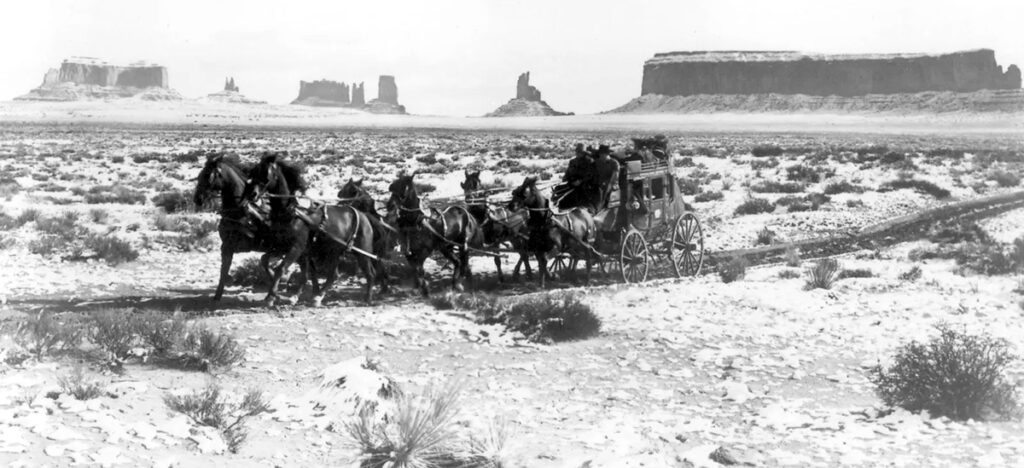
After years spent honing his craft in the movie business, Ford finally came into his own with this film as cinema’s premier western director, destined to later create such classics as The Searchers and The Man Who Shot Liberty Valance, both frequently cited among the top 10 western films of all-time. With Stagecoach, Ford breathed new life into the western, treating the genre with a seriousness never seen before. The film consequently became something like the genre’s blueprint for years to come due to its artistry, socio-psychological elements, and claims to the American cowboy myth.
Proving highly influential, traces of Stagecoach that can be found in the vast majority of the westerns that followed; beginning with the majestic landscapes of Monument Valley; as well as the music, camera work, production elements, or other tropes that we associate with the genre. Any film that has been mimicked so much, however, risks feeling obsolete, dated and worst of all – cliche. So tonight, you have to ask yourself, has Stagecoach become a relic better left to the past, or has it truly become a cinematic classic that stands the test of time?
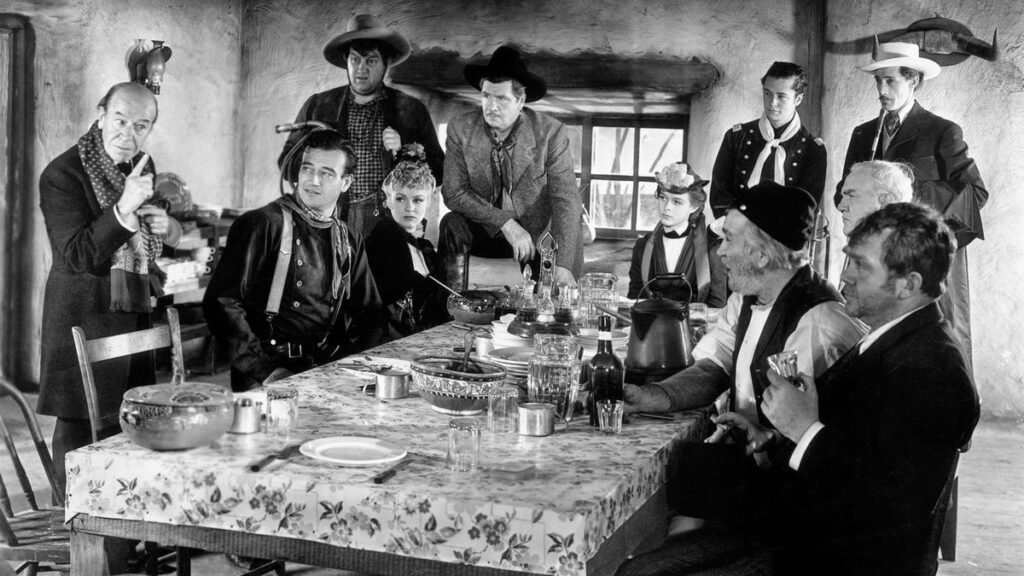 With an ensemble cast in every sense of the word, the film’s multiple characters represent western tropes – the hooker with a heart of gold, the outlaw, the drunken doctor, the banker, the helpless lady, the gentleman with a checkered past and more. Though their reasons for doing so differ, they end up traveling together on a stagecoach to a new town. To get there, they have to go through the treacherous Monument Valley, where they are constantly under threat from an Apache attack.
With an ensemble cast in every sense of the word, the film’s multiple characters represent western tropes – the hooker with a heart of gold, the outlaw, the drunken doctor, the banker, the helpless lady, the gentleman with a checkered past and more. Though their reasons for doing so differ, they end up traveling together on a stagecoach to a new town. To get there, they have to go through the treacherous Monument Valley, where they are constantly under threat from an Apache attack.
One of the film’s greatest strengths lies in the way this Apache threat establishes a feeling of dread that hangs over the heads of the cast throughout their journey together. Instead of focusing on individual character development, it uses basic character archetypes and develops them through events happening in the plot. The characters stand out as entertaining, with the exception of one or two that are just taking up space, but most of them get equal time to shine.
As a college film student at the University of Texas, I had never seen Stagecoach before, and I went into my first viewing of the film expecting very little. Anticipating a light, fluffy, action-adventure emerging from the silent film era, I couldn’t imagine John Wayne’s breakout performance carrying much weight or holding any deeper meaning. In my youthful arrogance, I thought it be a total waste of my time when we could be studying the likes of Bergman, Chaplin, Felini, Kurosawa, Lang, Lean, Murnau and D.W. Griffith. It even made me have a twinge of doubt in the intellectual wisdom of my beloved film studies professor, Chale Nafus. Man, was I ever wrong.
At its root, the film studies a group of people learning to support each other despite the differences they have or prejudices they hold. The more controversial characters – such as the outlaw and the prostitute – are shown in a brighter light than the ones society holds high, like the crooked and selfish banker. And clearly, it’s a message that still holds up today.
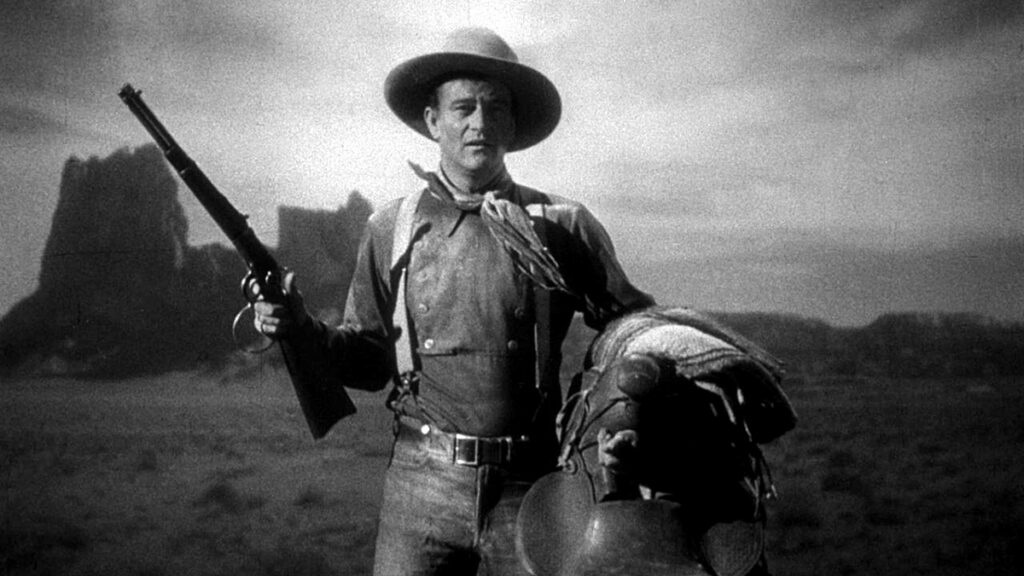 And then there’s John Wayne himself, playing the outlaw character, The Ringo Kid. It’s important to stress that at the time, John Wayne was nothing more than one of a posse of cowboy character actors languishing in B-movie western roles. But when the Duke makes his entrance in Stagecoach showcased in a beautifully-executed dolly shot moving in closer as he one-handedly cocks his Winchester 1892 Saddle Ring Carbine, we witness a star being born – it’s that good.
And then there’s John Wayne himself, playing the outlaw character, The Ringo Kid. It’s important to stress that at the time, John Wayne was nothing more than one of a posse of cowboy character actors languishing in B-movie western roles. But when the Duke makes his entrance in Stagecoach showcased in a beautifully-executed dolly shot moving in closer as he one-handedly cocks his Winchester 1892 Saddle Ring Carbine, we witness a star being born – it’s that good.
Although the role doesn’t call for much in terms of acting range, the Duke makes the most of it. Without a doubt, The Ringo Kid stands out as magnetic on screen, and his romantic angle with the prostitute serves as the heart of the story. Though in a sense many of the characters conform to stock archetypes – as in the hooker with a heart of gold to the lonely and misunderstood outlaw-rebel, they are each conflicted and complex. It’s not easy to define each as strictly a hero or a villain. Ford’s style is understated enough to see them with clear-eyed objectivity and yet empathetic enough to understand them, regardless of whether their decisions are admirable or not.
With that being said, the greatest aspect of the script may not even be the banter between characters, but instead the structure. On paper, Stagecoach is basically a perfect action-adventure film. The characters set off with the doom and gloom of death hanging over their heads, and the deeper they go, the closer they get to it.
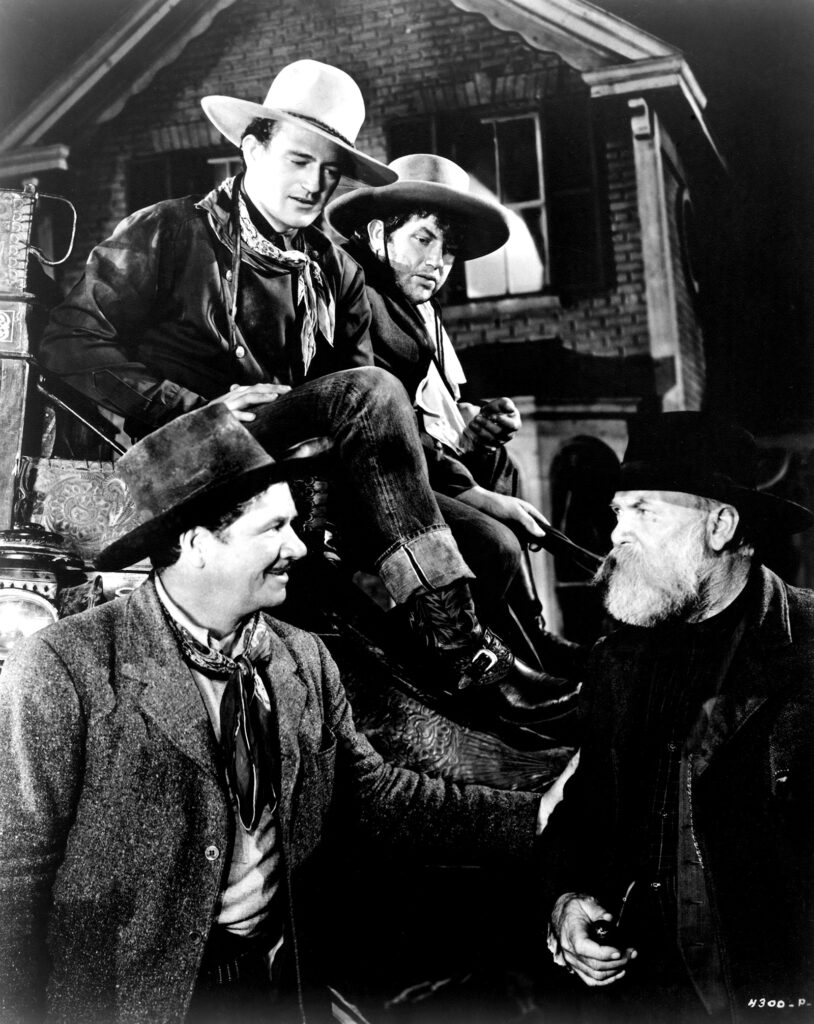 Interestingly enough, the climax isn’t a full-on battle with the Apaches, as that happens at the end of the second act. Instead, the film scales down to put the focus on the Ringo Kid and his relationship with the prostitute while also having to avenge his family by dueling a few morally inept gunslingers. It’s the perfect comedown from the thrills of the Apache chase as the film decides to speak to the viewers emotions. However, despite the duel being captivating, the last third of the film does not remain as compelling. Many of the characters just simply disappear because they have nothing more to do, making the story slightly anti-climactic, as if the ride ends a bit too soon and the ending doesn’t pack the punch we as viewers might have expected.
Interestingly enough, the climax isn’t a full-on battle with the Apaches, as that happens at the end of the second act. Instead, the film scales down to put the focus on the Ringo Kid and his relationship with the prostitute while also having to avenge his family by dueling a few morally inept gunslingers. It’s the perfect comedown from the thrills of the Apache chase as the film decides to speak to the viewers emotions. However, despite the duel being captivating, the last third of the film does not remain as compelling. Many of the characters just simply disappear because they have nothing more to do, making the story slightly anti-climactic, as if the ride ends a bit too soon and the ending doesn’t pack the punch we as viewers might have expected.
But when it comes to pure filmmaking, Stagecoach remains a marvel, especially for 1939 – possibly the greatest year for films in Hollywood history, producing the likes of Gone With the Wind, The Wizard of Oz, Goodbye Mr. Chips, Dark Victory, Mr. Smith Goes To Washington, Of Mice and Men and Wuthering Heights.
Just a couple of years later, Orson Welles gave us Citizen Kane in 1941 and pushed the art of filmmaking forward even further. Welles’ masterpiece is lauded for its breakthroughs in composition, such as his from-the-floor-to-ceiling shots, but it must be noted that Ford beat him to the punch two years earlier. Welles even declared that he watched Stagecoach 39 times while making Citizen Kane and claimed it was instrumental in influencing him.
It is easy to see why. Ford has a way with composition that makes it seem easy. While it’s as if the cinema gods created Monument Valley knowing that one day John Ford would be using it, his instinct for great-looking shots isn’t necessarily limited to the Monument Valley landscape, as his interiors are equally as impressive.
Sadly, I would be remiss if I didn’t mention that some aspects of this film have not aged as well. Despite the forward-thinking depiction of the outlaw and prostitute, there remains the ugly side to this film with its depiction of Native Americans specifically and minorities in general, either depicted as comedic relief, remorseless villains, or untrustworthy. Notorious for its barbaric portrayal of Native Americans, the central conflict of the film maintains that in order to get to Lordsburg, the stagecoach must travel through land ruled by Apaches, who are portrayed as nothing less than murderous monsters on a warpath.
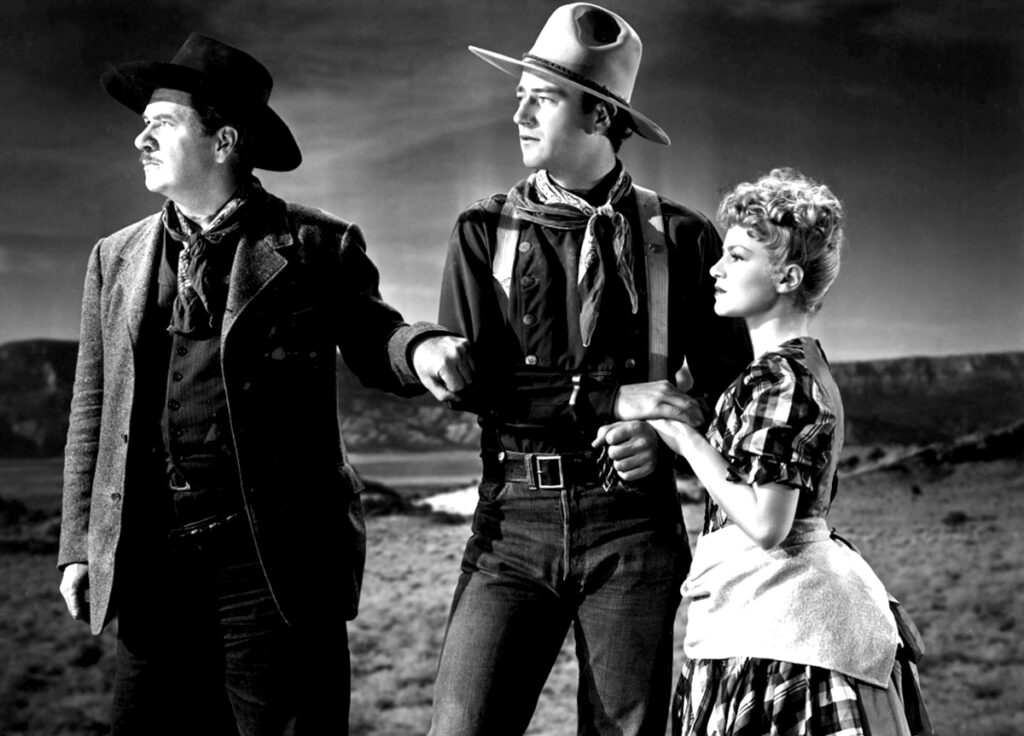 As with other racist-marred classics, such as The Birth of a Nation, The Jazz Singer and even Gone With The Wind, a lot can be learned by looking into the mechanisms of these attitudes as they are expressed in the film. Undoubtedly, it’s important to see these films for this reason on its own. But one can’t deny the formal brilliance and cinematic influence of a film simply because of a regrettable element.
As with other racist-marred classics, such as The Birth of a Nation, The Jazz Singer and even Gone With The Wind, a lot can be learned by looking into the mechanisms of these attitudes as they are expressed in the film. Undoubtedly, it’s important to see these films for this reason on its own. But one can’t deny the formal brilliance and cinematic influence of a film simply because of a regrettable element.
Therefore, despite its hypocritical prejudices, Stagecoach cannot be dismissed. The power of its filmmaking clearly reveals just how it managed to elevate the western from B-movie status to one of the most popular and important genres in film history. The poeticism of its style and the deeply felt characterizations were enough to make it a classic, but the strength of the film did something more. It established the wild west as the stage for the great American myth. By showing that even something as straightforward as a stagecoach ride could become a thrilling adventure, that every passenger in such a coach could have such an interesting story, it forever made the world of cowboys and gunfights the ultimate dream of America.
To this day, Stagecoach remains thrilling, funny, and whole-heartedly endearing, and it set the stage for the decades to come, not only for the Western genre, but action-adventure films in general with releases like Star Wars (1977) and Raiders of the Lost Ark (1981) owing much to Ford’s breakthrough. Containing a wonderful cast of characters and a theme of coexisting that remains relevant today, it proves that despite how films age and change, some things remain timeless.
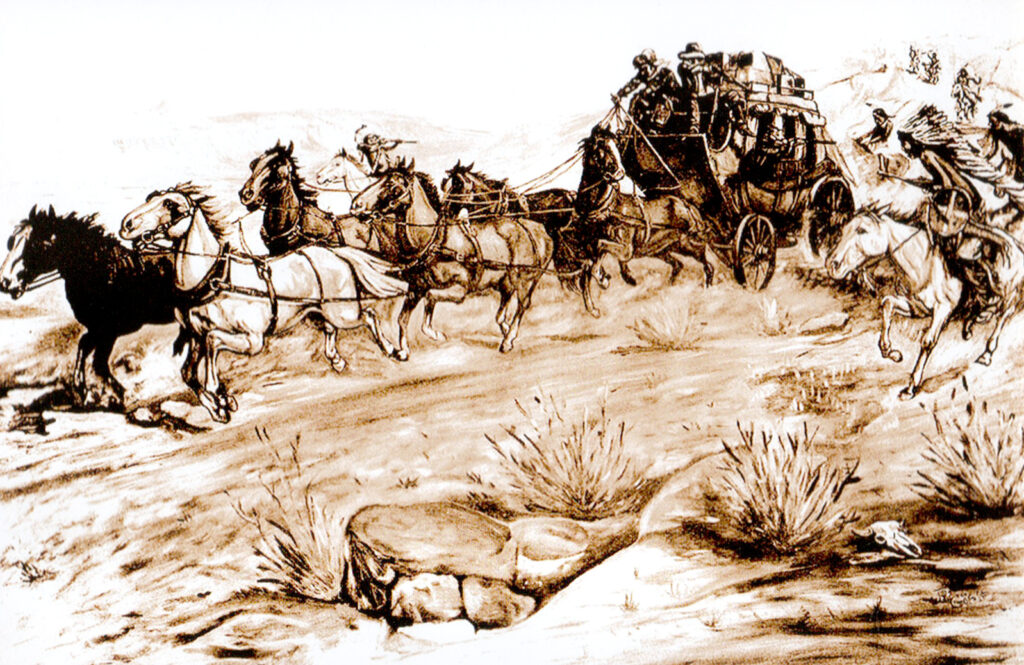 Even though I never saw this film until my college days, it stands out as special to me for all of the childhood memories it conjures up. My late uncle, Joe M. Gish, was a noteworthy artist once commissioned by the Texas Rangers Museum in Waco, a lifelong collector of wild west artifacts, and a classic cowboy movie historian.
Even though I never saw this film until my college days, it stands out as special to me for all of the childhood memories it conjures up. My late uncle, Joe M. Gish, was a noteworthy artist once commissioned by the Texas Rangers Museum in Waco, a lifelong collector of wild west artifacts, and a classic cowboy movie historian.
Upon his retirement in 1986, he was the curator of Gish’s Wild West Museum in Fredericksburg until the day he died in 2011. On his passing, the Texas Rangers escorted him to his final resting place, shutting down Fredericksburg. A reporter once wrote that Uncle Joe was a “tall, slim man looking all the world like the lead in an old Tom Nix western.” He was indeed.
As a boy, Uncle Joe fascinated me with true stories of the old West, using movies to teach me the difference between Hollywood and reality. Constantly sharing his collection with me, I was allowed to play with guns once owned by real life cowboys, gunslingers and U.S. Marshalls, often wearing their badges. And I was amazed by how easily Uncle Joe made his stories come to life through his art. This Stagecoach piece represents one of his original works of art inspired by this film, released when he was 15 years old. He watched it for the first time on the silver screen in a theatre much like The Cliftex for 23 cents. Here’s to you, Uncle Joe.
“Well, I guess you can’t break out of prison and into society in the same week.”
John Wayne as The Ringo Kid
